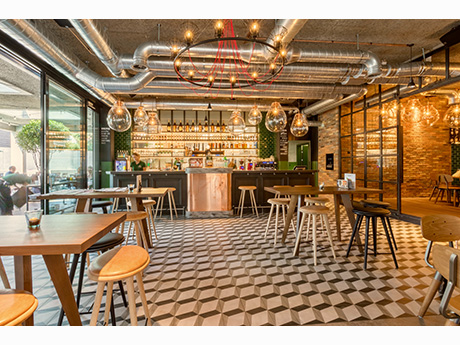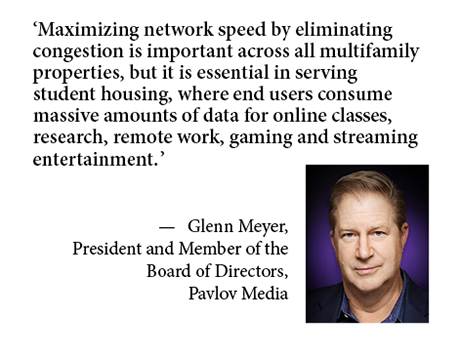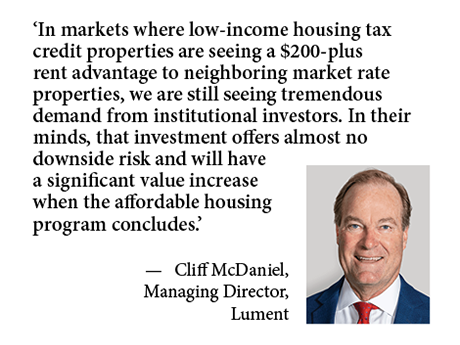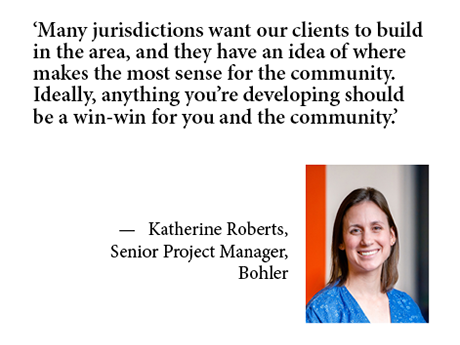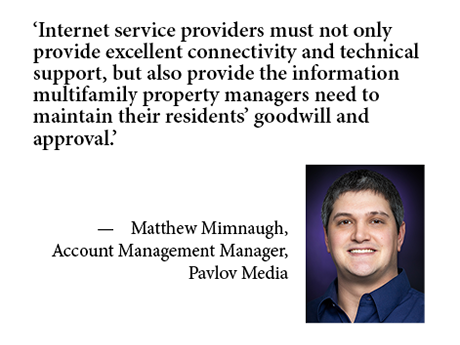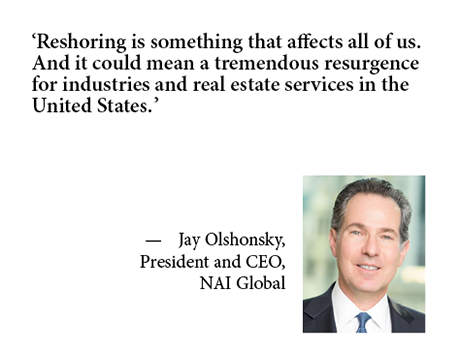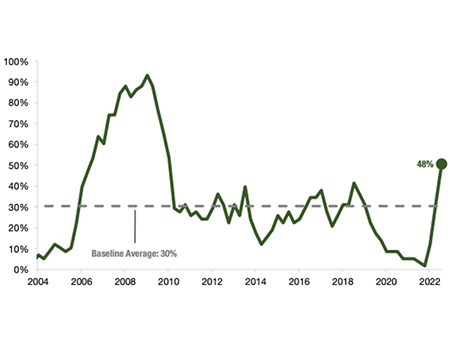High interest rates and economic uncertainty in the first quarter of this year contributed to lower absorption and declining rent growth in industrial, retail and multifamily sectors across the country, with some regional exceptions, according to Lee & Associates’ 2023 Q1 North America Market Report. Meanwhile office continues to struggle. The sector experienced its third-largest quarterly contraction since the beginning of the pandemic, as work-from-home preferences decoupled office occupancy from job growth numbers. The full Lee & Associates report is available (with further breakdowns of factors like vacancy rates, market rents, inventory square footage and cap rates by city) here. The analysis below provides an overview of four major commercial real estate sectors alongside trends, economic background and exceptions within each sector. Industrial Overview: Sharp Decline Hits First-Quarter U.S. Demand There was a sharp first-quarter decline in U.S. tenant demand for industrial space as wholesalers and retailers reconsider their inventory levels out of caution over the economic outlook. Net absorption in the first quarter totaled 39.4 million square feet, a 57 percent drop from the record set a year ago. The overall U.S. vacancy rate settled at 4.4 percent, an increase of 40 basis points from the close of 2022, comfortably …
Content Partner
Content PartnerDevelopmentFeaturesIndustrialLeasing ActivityLee & AssociatesMidwestMultifamilyNortheastOfficeRetailSoutheastTexasWestern
On the April 12 episode of “The Most Insightful Hour in CRE” webcast, Willy Walker, CEO of Walker & Dunlop, spoke to renowned economist Dr. Peter Linneman, founding principal of Linneman Associates, about pressing issues facing the economy, pandemic repercussions, market predictions and much more. The discussion began by diving into the economy and real estate market in its current state of flux, with many challenges facing both investors and developers. Walker outlines the unease created by the recent Silicon Valley Bank and Signature Bank crises. “One of the data points announced by the Fed is that since the crisis, bank lending in the United States has gone down by $110 billion over the two weeks since the Silicon Valley Bank collapse. Banks borrowed $160 billion in the two-week window prior. There’s a big drive toward liquidity; and yet there’s no new liquidity going out into the market.” “There’s 4.4 trillion dollars of commercial real estate (CRE) loans outstanding across all lending sources — CMBS, life insurance companies, banks, etc.,” continues Walker. “About half of that is non-multifamily properties. Banks hold about 40 percent of total outstanding loans on commercial properties.” If banks were to pull back from holding 40 percent …
Pavlov Media is accelerating the expansion of its fiber network and fiber-to-the-home initiatives with a key investment from the world’s largest infrastructure investor, Macquarie Asset Management. The funding will help Pavlov Media augment its coverage of student and multifamily housing, developing and broadening resident access to high-speed Internet across a variety of property types. “We are ramping up our growth plans with a combination of building municipal fiber networks in college towns and extending service to underserved areas adjacent to our core markets,” says Glenn Meyer, board member and president of Pavlov Media. “It’s basically more of what we have already been doing but on a larger scale.” Pavlov Media is already the nation’s largest private provider of fiber-based Internet and video services to off-campus student housing, connecting properties in more than 150 U.S. markets and Canada to its national backbone via its own last-mile, municipal fiber networks and third-party circuits. The Champaign, Illinois-based company serves approximately 1,000 multifamily and student buildings encompassing more than 285,000 beds, and in recent years has begun extending fiber to customers in areas adjacent to its core student-housing markets. Now the broadband service provider is poised to quicken the pace of its growth with …
AcquisitionsContent PartnerFeaturesIndustrialMidwestMultifamilyNAINortheastOfficeRetailSoutheastTexasWestern
Tax-Efficient Investment Strategies Open New Opportunities Despite High Interest Rates
The recent Silicon Valley Bank and Signature Bank collapses — and the takeover of First Republic Bank — have revived regulatory scrutiny on bank risk to a degree that is reminiscent of the financial crisis 15 years ago. Suddenly, it seems, everyone is concerned about the trillions of dollars in commercial real estate debt held at banks — and regional and community banks in particular — and whether it can be refinanced at higher interest rates as it matures over the next couple of years. The same holds for hundreds of billions of dollars of commercial mortgage-backed securities. The conditions are exacerbating a pullback in credit that started last year, which, along with the elevated interest rate environment, has depressed commercial real estate investment sales. In February, property sales dropped 51 percent, from $54.9 billion to $26.9 billion from a year earlier, according to MSCI Real Assets. Taken together, the wall of maturities, higher interest rates, bank collapses and a slumping economy have largely spooked the investment market, suggests Spencer Lund, chief investment officer with NAI Legacy in Minneapolis, Minn. (which also serves Chicago, Denver and Scottsdale, Ariz.) Still, it’s also the type of environment that breeds opportunity as prices …
AcquisitionsAffordable HousingContent PartnerFeaturesLumentMidwestNortheastSoutheastTexasVideoWestern
Higher Interest Rates Cause Affordable Housing Values to Return to Old Norms
Rising interest rates dinging commercial real estate and multifamily assets have plunged low-income housing tax credit (LIHTC) properties back into reality, especially those coming to the end of their 15-year compliance periods. “There were some huge profits made in the affordable housing space over the last two or three years,” says Cliff McDaniel, a managing director with Lument, which is representing Harmony Housing in the $1.4 billion sale of its affordable housing portfolio to the Michaels Organization. “We sold a lot of properties for $60,000 a unit or even $120,000 a unit, and the debt was $40,000 a unit. But the mania over that type of profitability is over, and values are going back to where they were before.” Up until about five years ago, the phrase “huge profits” and “affordable housing” would rarely if ever have occurred in the same sentence. Or even in the same story. Prior to that, affordable housing properties typically had very little value at the end of their initial 15-year compliance periods, and limited partners who provided equity to the project by buying tax credits routinely agreed to sell their interest to the general partner for a nominal fee. At that point, the …
As vacant sites become rare and cost-prohibitive, commercial real estate developers need to be creative when it comes to bringing a new project out of the ground. Unconventional development sites offer cost savings and location advantages, and in-depth due diligence and creativity on the part of developers can make for sites that can allow an elegant union of lower costs and strategy. With limited room for delay, how can developers think critically about available sites and leverage existing conditions to their advantage? Katherine Roberts, senior project manager at Bohler’s Warrenton, VA office, and Gregory Roth, principal at Bohler’s Tampa office, offer their expert advice on threading this needle. Bohler specializes in land development, especially making development work when conventional sites aren’t an option. Prioritizing Development Needs When Assessing Red Flags Certain project factors can be red flags if time or cost are obstacles to a developer, including These points of concern are usually knots that can be untangled if a developer has the time, money and appetite to move forward in spite of these interruptions, but each factor does bear watching. “Developers should understand where their limits are and where they’re willing to negotiate. Ideally, anything you’re developing should be …
By Matthew Mimnaugh, account management manager, Pavlov Media Account management, or the work to ensure repeat business and expand each client relationship, requires more than simply satisfying customers. For Internet service providers (ISPs) to the multifamily industry this means helping property managers succeed by maximizing their residents’ connectivity. Excellent Internet service leads to positive property reviews and renewed leases. Property ownership and management win. Providers that serve landlords best not only respond to service requests, but also employ a deductive approach to diagnose root problems, discover unreported deficiencies and take preemptive actions that allow smooth property operations. Below is an overview of best practices for account management and a discussion of Pavlov Media’s data analysis and behavioral pattern recognition tools we’ve developed to uncover trends and issues that can threaten connectivity and, ultimately, property performance. First Responders Giving housing managers and their residents access to a technology support team is a standard practice for many ISPs. Typically, a request generates a service ticket, and a team member responds to gather basic information before walking the customer through a scripted trouble-shooting tree to either solve the problem or elevate the ticket for more advanced assistance. This approach can be highly effective …
It’s little wonder that the fiber optic business is booming. American appetites for high-speed, high-volume Internet connectivity have skyrocketed in recent years, making fiber essential to provide Internet service across commercial property types. Employment for the linemen who build out and maintain those networks will grow 6 percent between 2021 and 2031, while telecommunications equipment installation jobs in general will expand to an even greater 8 percent, according to projections from the Bureau of Labor Statistics. Factor in the ongoing exodus of skilled workers from all trades as more of the nation’s Baby Boomers enter retirement, and many broadband providers may struggle to fill job openings in the coming years. That’s one of the reasons Pavlov Media, a Champaign, Ill.-based Internet service provider, is partnering with a Texas university to put students on career paths in fiber technology. Its partner in this endeavor, Prairie View A&M University, was founded in 1876 and is the second oldest public institution of higher education in Texas and one of the earliest 1890 Land Grant Institutions. Because it is a historically black institution, the program will be helping to address a longstanding need for greater diversity, equity and inclusiveness (DEI) in the technology sector. …
As economic uncertainty remains at the forefront, there is a continued quest to combat the multitude of challenges encountered by the manufacturing industry, as well as the trickle-down effects on commercial real estate markets. At the recent NAI Global Convention in Las Vegas, NAI Global president and CEO, Jay Olshonsky sat down with an industry leader who has spent the last decade mitigating these complexities. “It’s a very clear mission, to balance the goods trade deficit, the difference between imports and exports,” said Harry Moser, who founded the Reshoring Initiative in 2010 to bring manufacturing jobs back to the United States. “The deficit last year was $1.2 trillion and balancing that and bringing those jobs back at current levels of U.S. productivity will increase U.S. manufacturing by six million jobs, or about 40 percent.” The emphasis on reshoring is driven by a variety of factors, for example, rising labor costs in foreign countries and corporate understanding of the total cost of offshoring — including intellectual property theft, freight and tariffs. Companies desire greater control over supply chains, especially in a time of rising geo-political tension. By promoting a contained, local approach across the entirety of the manufacturing landscape, industry leaders …
Arbor Realty TrustBuild-to-RentContent PartnerDevelopmentFeaturesLeasing ActivityMidwestMultifamilyNortheastSingle-Family RentalSoutheastTexasWestern
Arbor Report Finds Rental Housing Insulated from Economic Contraction, Risk Factors Endure
— By Ivan Kaufman, founder, chairman and CEO of Arbor Realty Trust, Inc.; and Sam Chandan, a professor of finance and director of the Chen Institute for Global Real Estate Finance at the NYU Stern School of Business Rental housing is uniquely positioned to withstand tremendous economic headwinds. Although some observers point to the slowdown in apartment rent growth as a sign of growing weakness, this trend is a cyclical feature that is not reflective of any structural change in the profile of demand or supply. It is normal to expect a period of slowing rent growth while there is uncertainty in the economic outlook. In-depth findings on these trends, plus a thorough economic outlook for 2023 and a complete breakdown of risk factors, are detailed in Arbor Realty Trust Special Report Spring 2023: Navigating a Corrective Environment, from which this article is excerpted. While no asset class is immune from the challenges of higher interest rates, the presence of amortization, which spreads out a loan into a series of fixed payments over time, makes the multifamily sector less likely to see mounting distress. All Department of Housing and Urban Development (HUD)-conforming multifamily loans are fully amortizing. Moreover, Fannie …


